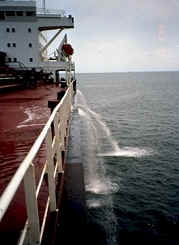Ballast water discharge and the environment
Ballast Water Discharge and the Environment
Ballast water discharge plays a crucial role in the operation of modern shipping but poses significant environmental threats. This article explores the impact of ballast water discharge on the environment, the species it affects, and the measures being taken to mitigate these impacts.
Overview[edit | edit source]
Ballast water is water taken on board by ships to stabilize and balance the vessel during transit. When a ship unloads cargo, it takes on water as ballast in one region and discharges it in another as cargo is loaded. This process is essential for safe and efficient maritime operations. However, ballast water discharge can introduce non-native invasive species into new environments, leading to significant ecological and economic consequences.
Environmental Impact[edit | edit source]
The discharge of ballast water is a major pathway for the introduction of invasive aquatic species. These species can outcompete native species for resources, alter habitats, and disrupt local ecosystems. Examples include the zebra mussel (Dreissena polymorpha) in the Great Lakes of North America and the toxic algae blooms caused by dinoflagellates in various parts of the world. The spread of these organisms can lead to the loss of biodiversity, affect fisheries, and impact water quality.
Regulations and Management[edit | edit source]
In response to the environmental threats posed by ballast water discharge, the International Maritime Organization (IMO) adopted the International Convention for the Control and Management of Ships' Ballast Water and Sediments (BWM Convention) in 2004. The convention requires ships to manage their ballast water to remove or kill invasive species before discharge. Technologies used for ballast water treatment include filtration, ultraviolet light, and chemical disinfection.
Challenges and Future Directions[edit | edit source]
While the BWM Convention represents a significant step forward in managing the risks associated with ballast water discharge, there are challenges in implementation. These include the development of effective and economically viable treatment technologies, ensuring compliance among international shipping fleets, and the need for ongoing monitoring and research to assess the effectiveness of management strategies.
Conclusion[edit | edit source]
Ballast water discharge is a complex issue that sits at the intersection of global commerce and environmental protection. While necessary for the operation of the world's shipping fleets, it requires careful management to mitigate its environmental impacts. Through international cooperation and the development of innovative technologies, progress is being made in reducing the threat of invasive species and protecting marine ecosystems.
This article is a environment-related stub. You can help WikiMD by expanding it!
Transform your life with W8MD's budget GLP1 injections in NYC from $125 and up biweekly
W8MD offers a medical weight loss program NYC and a clinic to lose weight in Philadelphia. Our W8MD's physician supervised medical weight loss centers in NYC provides expert medical guidance, and offers telemedicine options for convenience.
Why choose W8MD?
- Comprehensive care with FDA-approved weight loss medications including:
- loss injections in NYC both generic and brand names:
- weight loss medications including Phentermine, Qsymia, Contrave, Diethylpropion etc.
- Accept most insurances for visits or discounted self pay cost.
- Generic weight loss injections starting from just $125.00 for the starting dose
- In person weight loss NYC and telemedicine medical weight loss options in New York city available
Book Your Appointment
Start your NYC weight loss journey today at our NYC medical weight loss, and Philadelphia and visit Philadelphia medical weight loss Call (718)946-5500 for NY and 215 676 2334 for PA
Search WikiMD
Ad.Tired of being Overweight? Try W8MD's NYC physician weight loss.
Semaglutide (Ozempic / Wegovy and Tirzepatide (Mounjaro / Zepbound) available. Call 718 946 5500.
Advertise on WikiMD
|
WikiMD's Wellness Encyclopedia |
| Let Food Be Thy Medicine Medicine Thy Food - Hippocrates |
Translate this page: - East Asian
中文,
日本,
한국어,
South Asian
हिन्दी,
தமிழ்,
తెలుగు,
Urdu,
ಕನ್ನಡ,
Southeast Asian
Indonesian,
Vietnamese,
Thai,
မြန်မာဘာသာ,
বাংলা
European
español,
Deutsch,
français,
Greek,
português do Brasil,
polski,
română,
русский,
Nederlands,
norsk,
svenska,
suomi,
Italian
Middle Eastern & African
عربى,
Turkish,
Persian,
Hebrew,
Afrikaans,
isiZulu,
Kiswahili,
Other
Bulgarian,
Hungarian,
Czech,
Swedish,
മലയാളം,
मराठी,
ਪੰਜਾਬੀ,
ગુજરાતી,
Portuguese,
Ukrainian
Medical Disclaimer: WikiMD is not a substitute for professional medical advice. The information on WikiMD is provided as an information resource only, may be incorrect, outdated or misleading, and is not to be used or relied on for any diagnostic or treatment purposes. Please consult your health care provider before making any healthcare decisions or for guidance about a specific medical condition. WikiMD expressly disclaims responsibility, and shall have no liability, for any damages, loss, injury, or liability whatsoever suffered as a result of your reliance on the information contained in this site. By visiting this site you agree to the foregoing terms and conditions, which may from time to time be changed or supplemented by WikiMD. If you do not agree to the foregoing terms and conditions, you should not enter or use this site. See full disclaimer.
Credits:Most images are courtesy of Wikimedia commons, and templates, categories Wikipedia, licensed under CC BY SA or similar.
Contributors: Prab R. Tumpati, MD




